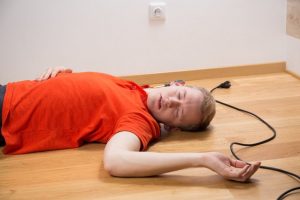A Guide To Making A Trailing Cable Hazard Injury Claim
By Stephen Moreau. Last Updated 25th July 2024. In this article, we investigate how a trailing cable hazard could lead to a personal injury claim. Tripping over a wire at work could occur in any workplace, including a building site, an office or a retail or catering outlet. If you trip over a trailing cable and injure yourself while at work, you might have a valid accident at work claim.
If legislation in place to help reduce workplace risk is not adhered to, and this causes you to sustain an injury, you might be able to make a personal injury claim. We explain the relevant legislation and what you will need to prove as part of your work-related injury claim.
If you decide to claim for your trailing cable hazard injury, you may wish to do so with a solicitor. To conclude, we look at hiring a No Win No Fee solicitor for your work injury claim.
To get in touch today:
- Call 020 3870 4868.
- Start your claim online.
- Use the live chat feature below.

Select A Section
- Am I Eligible To Claim For An Injury Caused By A Trailing Cable?
- What Injuries Could A Trailing Cable Hazard Cause?
- How To Claim For Injuries Caused By A Trailing Cable Hazard
- Compensation For Accidents At Work
- Contact A No Win No Fee Solicitor
Am I Eligible To Claim For An Injury Caused By A Trailing Cable?
If you sustain injuries when tripping over a trailing cable hazard, you might be eligible to claim compensation. While you are at work, your employer owes you a duty of care. This means that they must take all reasonable and practicable steps to ensure your health, safety and welfare in the workplace as per the Health and Safety at Work etc. Act 1974 (HASAWA).
Your employer is expected to adhere to relevant health and safety laws to help uphold this duty. In the case of trailing lead hazards, they will have to conduct a risk assessment in areas where cables may be used. From there, they will need to take steps to reduce the risk of injury. This could include removing the cables, ensuring they are secured to the floor, and signposting the hazard.
If your employer fails to do this and you suffer an injury as a result, you might be entitled to make an accident at work claim.
Please get in touch with our advisory team if you have any questions about this eligibility criteria or to see whether you may have a valid personal injury claim.
What Injuries Could A Trailing Cable Hazard Cause?
Many different scenarios could involve trailing cables and cause an injury. For example:
- A person suffers a head injury by falling over a trailing cable and hitting their head on the floor.
- Getting tangled in wires leads to a person tripping and falling down the stairs. This leads to a severe back injury, including extensive spinal cord and soft tissue damage.
- Falling over wires while holding a fragile object causes a person to suffer scarring from cuts and lacerations when the object smashes.
- A person gets their foot trapped in a tangle of wires, leading to them getting a broken ankle when they fall awkwardly. Alternatively, a trip over trailing wires could cause a broken wrist if the person puts out a hand to break their fall.
To discuss injuries caused by trailing leads, hazards in the workplace or accident at work claims in general, just give us a call.
How To Claim For Injuries Caused By A Trailing Cable Hazard
If a trailing cable hazard caused your injuries, you might be able to make a personal injury claim and seek compensation. Proving that employer negligence caused your injuries is vital to any workplace injury claim.
Evidence you could submit includes:
- Medical records.
- Photographs of the trailing wires and your injuries.
- Work accident log book.
As well as helping to gather evidence, a specialist work injury solicitor could ensure that your claim is filed within the personal injury claims time limit. The Limitation Act 1980 typically gives claimants three years to begin their work accident claim. Certain exceptions apply, however. These include:
- If you were aged under 18 at the time of the injury. A litigation friend could start a claim on your behalf prior to your 18th birthday. If a claim is not started on your behalf, however, you will be given three years after your 18th birthday to start a claim yourself. While you’re under 18, the time limit is frozen.
- If you lack the mental capacity to claim following your trailing cable hazard accident. If this is the case, you will be given three years in the event that you regain the capacity to start your work injury claim. No time limit applies while you cannot pursue your own claim, and a litigation friend can claim on your behalf.
Our work injury claims team can help you start your personal injury claim today. Get in touch for free legal advice.
Compensation For Accidents At Work
If you make a successful claim for injuries caused by a trailing cable hazard, then the amount of compensation you can receive will depend on several factors. These include:
- How many injuries you are claiming for.
- The types of injuries you have.
- How serious they are deemed to be.
You will be awarded general damages for a successful personal injury claim and possibly special damages as these are the two heads of loss in compensation claims. General damages accounts for physical pain and emotional suffering experienced as a result of your injuries.
The table below contains compensation guidance brackets from the Judicial College Guidelines (JCG). Those who assign a value to your claim may use the JCG as a reference, as it provides guideline compensation amounts for different injuries and illnesses. Please note that the top entry is not a JCG figure.
| Injury | Severity | Amount |
|---|---|---|
| Multiple Severe Injuries And Financial Damages | Serious | Up to £1,000,000+ |
| Head | Very Severe | £344,150 to £493,000 |
| Head | Less Severe | £18,700 to £52,550 |
| Knee | Severe (ii) | £63,610 to £85,100 |
| Pelvis and Hips | Severe (iii) | £47,810 to £64,070 |
| Arm | Less Severe Injury | £23,430 to £47,810 |
| Leg | Fractures From Which an Incomplete Recovery is Made or Serious Soft Tissue Injuries | £21,920 to £33,880 |
| Bodily Scarring | A Number of Noticeable Laceration Scars or One Single Disfiguring Scar | £9,560 to £27,740 |
| Shoulder | Serious | £15,580 to £23,430 |
| Back | Minor (i) | £9,630 to £15,260 |
| Wrist | d) | £7,420 to £12,630 |
Special damages are the second head of claim that your compensation could cover. This covers financial expenses or losses caused by your injuries. Examples could be the cost of home care provisions or loss of earnings.
You can get more advice on what compensation you could receive if you have a successful claim after a tripping accident by contacting our advisors today.
Contact A No Win No Fee Solicitor
You may decide to hire a No Win No Fee solicitor for your work injury claim. They may offer to provide their services under a Conditional Fee Agreement (CFA) which is a kind of No Win No Fee agreement.
This type of arrangement means your solicitor will not charge upfront in order for them to start work on your claim. If your claim is not successful, your solicitor will generally not ask you to pay for their services. If your work injury claim succeeds, however, a legally capped percentage of your award will be taken as a success fee.
Contact our work accident claims team for free legal advice. If your trailing cable hazard claim seems like it has a good chance at being successful, you could be connected with our panel of No Win No Fee work accident solicitors.
To discuss your compensation claim for tripping over a trailing lead:
- Call 020 3870 4868.
- Start your claim online.
- Use the live chat.

Resources On Workplace Trips And Falls
For additional reading and resources, check out the links below:
Further articles from UK Law:
- Proving Liability After an Accident at Work
- Scaffolding Injuries
- Medical Expenses for an Injury at Work
If you have questions about claiming after a trailing cable hazard has caused injuries, speak with an advisor today.



